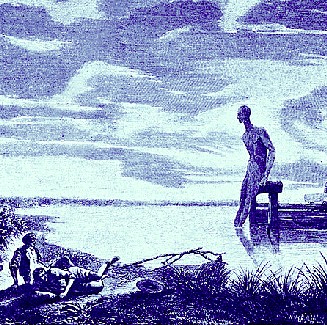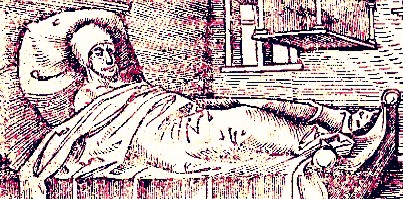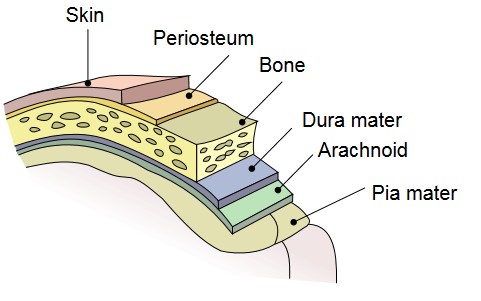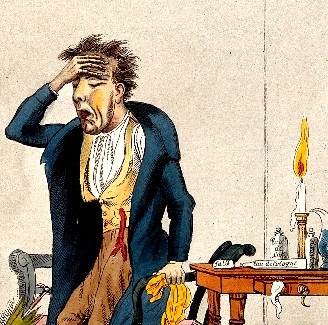
Headache Treatment Page Menu: 1 2 3 4 Next>>
Treating Headaches During the Golden Age of Piracy, Page 2
Headaches Accompanying Other Issues - Fevers
There were a variety of types of fevers identified during this period, several of which were recorded as accompanied by headaches. Physician Thomas Willis gives a fascinatingly detailed explanation of why headaches accompany "a putrid Synochus, or continual fervor [fever] without intermissions":

Author Thomas Willis
The pain of the Head, in Feavers is excited, because the Meninges of the Brain, being pulled or hauled With Vapors, and with a sharp Blood, and hot, for the Blood being impetously moved, by reason of the direction of the great Artery, is carried in a greater plenty to the Head, than to the lower parts; because the passage from the bottom of the Heart to the Head, is straight... wherefore, as the membranes are very sensible, and that there the Blood is stopped, and reverberated, in its rapid course, it is no wonder, if cruel Head-aches are excited in Feavers. Besides, it is Impetuous flowing of the Blood, wherewith (as it were by a certain Ramming) the membranes of the Head being distended, ake grievously; also sometime, Head-aches arise, by reason of the Nervous Juice (which is supplied from the burning Blood) being too sharp and pricking; wherefore, when the membranes, and nervous parts are watered with the same they being pulled by its acrimony, are moved into Pains and Convulsions.1
It is interesting that Willis' explanation runs along the same lines that Charles Allen identified on the previous page when discussing headaches accompanying toothaches. This explanation is humoral, pointing the finger at blood as being the cause of a headache. Willis suggests that blood bears a two-fold responsibility here. First, it shoots into the skull with such force that it 'rams the membranes' and, having no where else to go, continues to pound around in the head. Second, the 'burning' blood supplies a 'Nervous Juice' which is corrupt, further inducing a headache in a fever.
Sea surgeon John Moyle doesn't give elaborate theories as to why a fever causes a headache, preferring to simply identify the types of fevers that are accompanied by them. He first notes that a

Artist: Jean Francois Maurice Dudevant
Malaria Allegory - "The Ghost in the Swamp" (19th century)
"grievous Head-ach" is symptomatic of "This Distemper of the Sea called a Calenture, and at land the Camp-Fever".2 Camp-fever, also called in various sources "gaol [jail] fever" and "ship fever" is today called typhoid. "The germs causing it are passed from the body in the excretions, so it can be understood how easily food and water became contaminated."3
Moyle also said that other agues (fevers, typically resulting from malaria) came with headaches. This was the result of the "burden of corrupt humours that are on the Heart, and Stomach, and Head; hence comes the grievous Head-ach and Vomiting"4.
Moyle goes on to examine various types of fevers caused by malaria, suggesting which humors caused them.
All men know that the Quartans [malarial fevers recurring every fourth day] are the worst of Agues, and continue longest, having more of a vitiated [spoiled] Melancholly Nature in their cause. And Tertians [malarial fevers recurring every third day] are found to be bad enough from putrid Flegm, but however not so lasting as the other. And again Quotidians [malarial fevers recurring every day] are more of a Cholerick Nature [the humor black bile], hot and fierce, but not long lasting, unless they degenerate from that to another (as sometimes Agues do.)5
It is curious that Moyle assigns the cause of each of the malarial fevers to a different humor.
1 Thomas Willis, Dr. Willis’s Practice of Physick, p. 86; 2 John Moyle, The Sea Chirurgeon, p. 159; 3 William Rayner Thrower, Life at Sea in the Age of Sail, p. 164; 4,5 Moyle, p. 193-4
Headaches Accompanying Other Issues - Measles
Headaches also heralded an attack of measles. Sea surgeon John Moyle explains that "Men, (especially the younger sort) have these Diseases [measles and small pox] in a Ship. They are usually taken at first with a dulness or heaviness, and then a pain in the back, with grievous Head-ach."1 Ambroise Paré explains how he thought this occurred, noting that "patients

Artist: Frank Holl - From Despair (1881)
often sneez when as these matters seek passage out, by reason of the putrid vapors ascending from the lower parts upwards to the brain. They are held with a continual Fever, with pains in their backs, itching of their nose, head-ach, and vertiginous [vertigo-causing] heaviness"2.
1John Moyle, Abstractum Chirurgæ Marinæ, p. 123; 2 Ambroise Paré, The Apologie and Treatise of Ambroise Paré, p. 491
Headaches Accompanying Other Issues - Parotid Tumors
Parotid tumors occur in the salivary glands near the ears. In fact, parotid is Latin for 'tumor near the ear". Some period surgeons reported that headaches accompanied such tumors. Matthias Gottfried Purmann also reported a case where a woman had "a large Tumour in her Left Ear... Before she perceived the Tumour, she was tormented above half a Year with a Violent Head-ach, especially in the Forenoon"1.
Ambroise Paré says that when they have such tumors "the patient is troubled with the Head-ach and all his face becomes swoln."2 Paré provides an explanation for this which will sound quite familiar by now. H explains that "the excrements of the brain increased in quantity or quality rushing thither of their own accord. Such abscesses often have great inflammation joyned with them, because the biting humor which flows thither is more vitiated [spoiled] in quality than in quantity. Besides also they often cause great pain, by reason of the distention of the parts indued with most exquisite sense"3. Once again we find the explanation that the force and malignity of the humors in the head cause headaches.
1 Matthias Gottfried Purmann, Churgia Curiosa, p. 53; 2,3 Ambroise Paré, The Workes of that Famous Chirurgion Ambrose Parey, p. 228
Headaches Accompanying Other Issues - Syphilis
Syphilis

Ulrich von Hutten in Bed Suffering From Syphilis (16th c.)
(or the Pox) was often accompanied by headaches. When listing the symptoms of the disease, sea surgeon John Moyle explained that as syphilis coursed through the blood, "spots appear; and likewise the Bones, so that Nodes are present; and phagadenick Ulcers [cutaneous ulcers that spread rapidly] are in the Mouth and Throat, and in divers parts of the Head and Body, with grievous Head-ach and night pains. This is a Confirmed Pox."1
Ambroise Paré's syphilitic symptom list similarly includes "fixed pain of the head, knots and rottenness of the bones, ill-natur'd ulcers in a bodie verie much fallen away and weak, whereof the cure hath been alreadie sundrie times undertaken"2.
1 John Moyle, The Sea Chirurgeon, 4th ed., 1702, p. 216; 2 Ambroise Paré, The Workes of that Famous Chirurgion Ambrose Parey, p. 468
Migraine Causes
Many of the period authors under study don't seem to differentiate between migraine and other headaches. Some refer to long-lasting headaches without particularly identifying them as migraines.1 However, some do identify them specifically, usually calling them "megrims", which seems a particularly fitting description of such a headache.
Ambroise Paré goes into great detail about migraines, first explaining the variety of pains the patient may feel. He identifies a wide range of causes, saying megrims

Diagram of the Meninges on the Skull, Drawn by the SEER Development Team
proceedeth from the veins and external arteries, or from the meninges [the membranes surrounding the central nervous system], or from the verie substance of the brain or from the pericranium, or hairy scalp covering the pericranium, or lastly from the putrid vapours arising to the head from the ventricle, womb, or other inferior member. Yet an external caus may bring this affect, to wit, the too hot or cold constitution of the encompassing air, drunkenness, gluttonie, the use of hot and vaporous meats, som noisome [offensive] vapor or smoak, as of Antimonie, quick-silver [mercury], or the like, drank up by the nose, which is the reason that gold-smiths, and such as guild metals are commonly troubled with this diseas.2
It would seem that Paré thought almost anything could cause migraines.

Artist: H.C Wellcome
A Man With an Excruciating Headache (1827)
He goes on to explain the internal processes behind migraines, which included "plenty of vapours mixed with the humors, and shut up in the nervous arterious, or membranous bodie of the head."3 These humors sometimes putrify, bringing on a fever.
As befits his multiple migraine causes, Paré differentiates between types of migraines based on the type and amount of pain the patient feels. He uses this to identify their origins.
If the pain bee superficiarie, it is seated in the pericranium. If profound, deep and piercing to the bottom of the eies, it is an argument that the meninges are affected, and a feaver ensue's, if there bee inflammation, and the matter putrefie; and then oft-times the tormenting pain is so great and grievous, that the patient is afraid to have his head touched, if it bee but with your finger, neither can hee away [put up] with anie nois[e], or small murmuring, nor light, nor smels however sweet, no nor the same of Wine.4
His description of the more caustic migraine will likely ring true for those who have experienced them.
1 See Matthias Gottfried Purmann, Churgia Curiosa, p. 53 for example; 2,3,4 Ambroise Paré, The Workes of that Famous Chirurgion Ambrose Parey, p. 401

